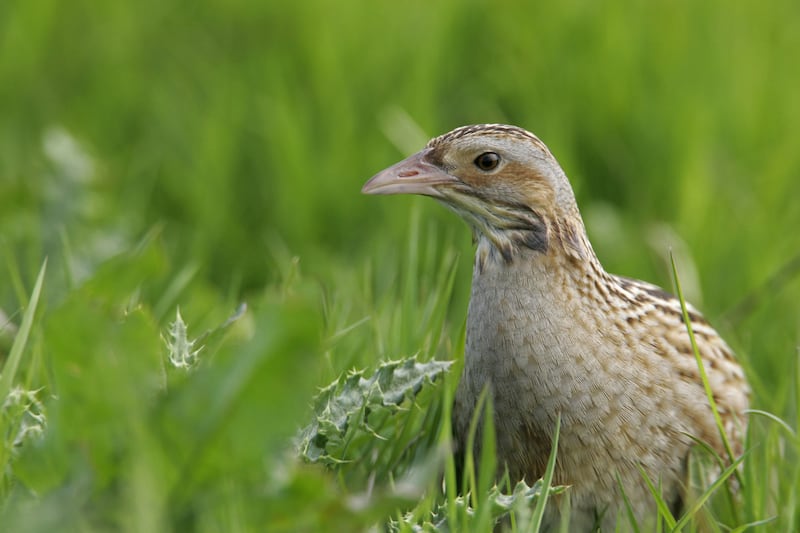For years when farmer Colum Ginnelly saw a purple-flowering thistle while walking his land he would “give it a swipe with a hurley” or any stick to hand. To him, it was a weed; his instinct was to destroy it.
“Now when I go into the field I keep a wide berth of it in case I knock it over,” says the 50-year-old, who farms almost 500 acres near Mulranny, Co Mayo.
“A change in mindset” has, he says, resulted in his changed attitude to thistles and other plants.
In the week when the EU’s Nature Restoration Law was agreed, many are wondering what impact it will have, especially for the farming community in Ireland.
READ MORE
But thousands of people and several communities throughout the country are already involved in a range of EU-funded restoration programmes.
Ginnelly is one of about 820 farmers involved in the Life IP Wild Atlantic Nature (WAN) project that is focused on 35 blanket bog project sites in Donegal, Leitrim, Sligo, Mayo, Galway and Cavan.
As a fifth-generation sheep farmer whose animals graze on the mountain, on the lowlands and on islands in Clew Bay, he helped to encourage another 140 farmers in the Nephin Beg area to sign up for the results-based payment scheme co-ordinated by the National Parks and Wildlife Service (NPWS).
“The higher the ecological value (of the land), the higher the score, and the higher the score the higher the payment the farmer receives,” says Derek McLoughlin WAN project manager.
Payments made under the Wild Atlantic Nature programme range from €800 to €15,000.
Ginnelly, a father of three, and his mother have been farming since the 1990s when his father died suddenly of a heart attack. He joined the WAN project about three years ago and says it has changed how he views the land.
“All of a sudden we started to realise what was beneath our feet – the flowers and plants,” he says.
Measures taken by participants such as reducing stock (even a little), reducing use of fertilisers and chemicals and “lick” spraying rushes to ensure other plants aren’t killed, has yielded obvious results.
Ginnelly has his own views on how farmers will embrace changes that the new law will bring.
“Farmers are great to take new challenges on board but we don’t like when the whip is got out. My father was heavily involved in IFA over the years,” he says.
“If it is explained to farmers, they go above what they are asked to do, but if you dictate it does not work.”
Leitrim-based organic farmer James Gilmartin is a “Farming for Nature” ambassador, in recognition of his efforts to enhance biodiversity. His solar-powered mobile henhouse is moved regularly, often following his cattle’s grazing patterns.
He uses an app on his phone to operate the no-fence GPS collars he puts on the cattle in order to move them around and manage his species-rich upland grasslands.
The seventh-generation farmer, who is also a teacher, recently topped the poll as a first-time Independent candidate in the local election in Leitrim.
He might have been expected to be effusive about the new EU law, but he has concerns.
“In principle, it is a good thing.” he says. “For the last 40 years, rightly or wrongly, we have been following national policy that has led to intensification on all land types in Ireland, which has had pretty serious effects.”
The beauty of it all is that in an area of no peatland conservation we went from cutting and burning to conservation in a few short years without any conflict. We are very proud of that
— Gearóid O’Foighil
His concern is his uncertainty about how the new regime will be funded and what happens when public land runs out and private land will be needed to meet Ireland’s targets. He believes many farmers “in this part of the world” are already doing their share when it comes to restoration.
Vet and part-time farmer Feargal Ó Cuinneagáin is definitely doing his share for the corncrake. He bought 25 acres on the Mullet peninsula in 2011 in an area once synonymous with the corncrake.
“In 1994 on that peninsula they were down to two calling males. So they were on the verge of extinction,” he says.
Ó Cuinneagáin has planted beds of nettles, providing the perfect height cover for the corncrake on his land near Belmullet.
“They come at the end of April,” he said. “There is not enough cover in grass meadows so they need nettles or hogweed or cow parsley or flaggers.”

This year there were four calling males on his farm and five on the neighbouring farm, making this the highest number of corncrakes since the 1980s.
“I kind of live for the corncrake,” he said. “I put about 100 days’ hard labour into the farm every year and once you have a corncrake calling that is the reward”.
He is quick to point out that there is a financial reward too for participants in schemes such as Corncrake Life or Corncrake Farm Plan which are co-ordinated by the NPWS.
The average payment under the Corncrake Life scheme in 2023 was about €3,000, says the NPWS.
Payments vary depending on the quality and quantity of land farmers prioritise for nature. In the past five years, there has been a 35 per cent increase in corncrake territories.
“It has been transformative for communities and landscapes, and indeed the corncrake population,” a NPWS spokesman says.
Ó Cuinneagáin has also been attracting snipe – the wading bird with the characteristic long, slender bill – to his species-rich fen.
He grows a tillage crop to attract twite – a type of finch – which he says is “on the verge of extinction” in Ireland.
“There are only about 50 pairs left in the country. I have wintering birds. They breed on the cliffs on Erris Head and during the winter they come to my land to feed,” he says.
His conservation work extends to the great yellow bumblebee, now an endangered species in Ireland.
“The most crucial thing he needs is late flowering species like knapweed so I don’t mow until October,” he says.
Derek McLoughlin, who leads the WAN project in the west and north west, thinks the perceived conflict between the farming community and environmentalist is over-stated.
“Farmers, I think, are the most innovative group in society in that they trouble shoot every day,” says McLoughlin.
“Rural areas are always very vulnerable to dramatic policy changes. But the reality is that for 30 to 40 years we have had expectations of farmers, of the type of production of food that is unrealistic and loss-making for parts of the midlands and north west.
“The approach we are taking now is: this is what your land is capable of.”
“You can farm with nature now and be rewarded for it and enjoy it rather than struggling.”
— Colum Ginnelly
Gearóid O’Foighil is involved in a conservation project at Scohaboy bog near Cloughjordan, Co Tipperary. A 1,500-acre raised bog and natural heritage area, the land was until quite recently a place where 44 householders expected to cut their turf for the winter.
Cloughjordan Community Development Association, an umbrella for many local community groups such as the heritage group, the Tidy Towns and the Christmas lights committee, played a lead role liaising between locals and State agencies on a large restoration project there.
“The beauty of it all is that in an area of no peatland conservation we went from cutting and burning to conservation in a few short years without any conflict. We are very proud of that,” says O’Foighil.
There has been “an explosion of bog cotton” and other plant species as a result of the restoration project, he says.
The willingness of people who had traditionally cut turf to see the benefits of conservation, he attributes to “peer influence” and “ordinary people talking to ordinary people”.
On a week when the EU law was passed in Brussels – followed swiftly by the announcement that Eamon Ryan is quitting as Green Party leader – he seems optimistic, despite commenting that “some people are not interested in listening” when it comes to environmental matters.
“I am not a Green Party member or a member of any party but I think he has played a blinder,” he says.
“He has been unfairly savaged but with the cards he had available to him, I think he has done a fantastic job and I think politics will be poorer without him.”
Fifth-generation farmer Colum Ginnelly supplements his farm income by running a tour bus company.
“I am not sure if I want my kids doing what my father did, killing himself farming,” he says.
“You can farm with nature now and be rewarded for it and enjoy it rather than struggling.”
- Sign up for push alerts and have the best news, analysis and comment delivered directly to your phone
- Find The Irish Times on WhatsApp and stay up to date
- Our In The News podcast is now published daily – Find the latest episode here



















